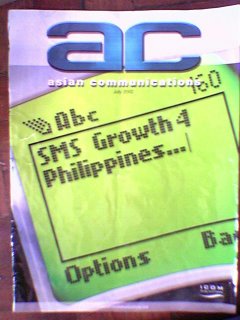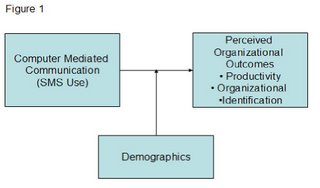
(Published in the cover story of Asian Communications, an international trade journal, July 2002 issue)
Reynaldo C Lugtu jr, who is writing his business administration doctorate at De LaSalle University, The Philippines, links SMS to productivity and organisational identification.
SMS text messaging to mobile phones has caught everyone by surprise. An astounding 75 billion text messages were sent globally in Q1 2002, representing an increase of more than 50 per cent on the same period in 2001. The Philippines, text capital of the world, exchange an average of 120 million text messages per day - or more than 10 text messages per subscriber per day. According to Mobile Lifestream, a research firm, SMS will be used for another seven years because handsets, standards and awareness are all here today.
Despite all these, SMS is still largely a consumer phenomenon and corporate applications are limited. At the basic level, many workers send SMS for collaboration, providing appointment reminders, and sending notifications of incoming emails and faxes. With such a large installed and active number of users, the time really has now come for businesses of all sizes to take a close look at mobile messaging and to think about how they can use it to best advantage.
In a survey by UK-based software development firm Peramon, SMS is the most important area of mobile technology for corporate decision-makers in the UK this year. Peramon further declared: SMS can impact the corporate “bottom line” immediately. By taking SMS seriously, businesses can drive down the cost of their mobile communications at the same time as increasing employee productivity. The firm believes that a truly effective mobile data strategy integrates all available methods of communication, including voice, email and SMS, to generate greater productivity.
SMS can increase operational efficiency by dispensing with redundant costly mobile phone calls and out-of-date email messages. While most corporates tend to use voice as the primary means of business communication, SMS provides a low-cost way to keep workers in-touch. A very strong value proposition exists in the organisation setting, which will fuel a next wave of employee productivity and process improvement.
Research into SMS use
There are nine million mobile phone service subscribers in the country, exchanging an average of 120 million text messages per day or more than ten text messages per subscriber per day. According to the Asia Market Intelligence Survey of office workers, one out of two Filipinos use their mobile phones to stay in touch with their office at all times; and SMS has become a popular tool for office-related matters with more than half of the office staff using it. Since a worker spends the majority of his time at work, the average worker is therefore sending the majority of his text messages during working hours.
With all these in mind, the author conducted a research study on SMS as part of a doctoral research paper. Specifically, the objective of the research was to determine the association between SMS usage patterns among employees in an organisation, and worker productivity and organisational identification.
The study focused on a single trading company in the consumer goods industry with a nationwide sales organisation. The subjects of the study are the employees (managers, professionals, and staff) of a sales and distribution company engaged in various task groups within the organisation.
The purpose of the study is to determine the correlation between the SMS usage patterns among employees of a trading firm and organisational outcomes. A sales organisation was selected because there is more coordination and collaborative communication among salesmen, sales managers, and staff. The survey questionnaire was administered among the 37 employees out of 50 who owned mobile phones and who were present at the time of the survey.
A questionnaire was used to collect responses from the sample. It consisted of two parts: firstly demographic characteristics and SMS usage patterns, and secondly perceived organisational outcomes. The latter consisted of a five-level scale, with level 5 as “Strongly Agree” and level 1 as “Strongly Disagree”.
Framework
 The research was based on studies of Computer-Mediated Communication (CMC). CMC refers to human communication via computers - including mobile phones. CMC is a variable that enhances productivity and organisational identification, with demographics as moderating variable (figure 2).
The research was based on studies of Computer-Mediated Communication (CMC). CMC refers to human communication via computers - including mobile phones. CMC is a variable that enhances productivity and organisational identification, with demographics as moderating variable (figure 2).Efficiency and effectiveness are related to productivity. Efficiency is defined by the relationship between the inputs and outputs. Effectiveness, however, relates to the quality of the output; in this case collaborative decision-making or joint problem-solving pertains to the quality of decisions based on the speed of information and collaboration among employees.
According to CMC studies, it supports coordination, scheduling and joint problem solving. CMC also contributes to greater efficiency for tasks requiring rapid responsiveness – recipients are likely to respond more quickly in consequence.
By providing a psychological link between workers and the organisation, CMC enhances organisational identification. Organisational identification is a means by which organisational members define the self in relation to the organisation. It facilitates coordination because it leads to convergent expectations. Identification motivates members to coordinate their efforts to achieve organisational goals by enhancing interpersonal trust and cooperation. Organisational identification is expected to correlate with work effort, willingness to perform extra-role behaviours, and task performance.
SMS usage patterns
Table 1 and figure 1 show the SMS usage patterns in the workplace. The majority of the respondents exchanged 11 to 15 SMS per day (29.7%) with the average at within 10 to 11 SMS per day. This is consistent with mobile subscriber statistics. Most employees exchange work-related SMS in the morning (55.6%) with the average residing between morning and lunchtime. When exchanging work-related SMS, most employees send process-related SMS (48.5%), eg, delivery, payment terms, and invoicing; and again a majority uses SMS because it is cheaper than voice call (52.8%).
Employees are sending work-related SMS to co-workers, managers, subordinates, and customers (54.1%, 75.7%, 48.6%, and 43.2%, respectively). The frequency of SMS to communicate with co-workers has the largest affirmative response rate, with 94.6% saying they “seldom”, “often”, and “always” use SMS to communicate with colleagues.
Organisational outcomes
Figure 2 shows the average response ratings of respondents in organisational outcome groups. All three organisational outcome factors received affirmative responses, ie, respondents “agree” that SMS use in the workplace contributes to efficiency, collaborative decision-making, and organisational identification, with the latter receiving the highest response rating.
Table 2 shows the correlation coefficients between SMS use patterns and organisational outcomes. Only strong significant correlations are presented. Two similar SMS use-patterns - “Number of SMS per Day” and “Work-Related SMS Frequency per Day” together with “SMS Frequency to Co-workers” are all strongly correlated to efficiency and collaborative decision-making items. It is noteworthy that SMS Frequency to Co-workers has a stronger correlation to efficiency and collaborative decision-making than does SMS Frequency to Managers. This may be due to the greater need for coordination and information sharing among co-workers, especially among salesmen and support staff. However, the reverse is true for correlation to organisational identification, wherein SMS Frequency to Managers has a stronger correlation to such organisational identification. This may mean that subordinates feel a strong sense of belonging to the company when they can openly communicate with their managers via SMS.
Two SMS use-patterns (SMS Frequency to Customers and SMS Frequency to Subordinates) have weak correlations to organisational outcomes. This may mean that employees do not use SMS to communicate with their customers. The other may be due to the low sample size of managers (21.6%).
Cellphone ownership has strong correlations with items in the collaborative decision-making group, ie, those employees with company-issued phones perceive greater effects on their collaborative decision-making. This may be a natural response as employees with company-issued phones maximise its use for coordination and joint problem solving.
Table 3 shows the correlation of “SMS Time Sent During the Day” and “Occupation” with specific questionnaire items. “SMS Time of Day” is strongly associated with “SMS as Effective Means of Communication” and “More Work Coordination through SMS”. This indicates that it is in the morning that employees perceive greater contribution of SMS in effective communication and coordination with colleagues.
“Occupation” or level in the organisation is strongly associated with “Value and Importance of Work-related SMS”. This may mean that the higher the hierarchical position of the employee, the greater is the perceived value and importance received from other employees. Senior management in a company may tend to send and/or receive only important and urgent text messages.
Implications for service developers and organisations
It has been recognised in the telecoms industry that SMS is here to stay for another five to seven years. The results of this study reveal the potency of SMS as a medium to enhance productivity, collaboration, and organisational identification in organisations. Several recommendations are put forward in order to maximise the use of this communication media.
To begin with, for organisations SMS can be used to maximise productivity gains from this medium. Such applications as e-mail notification, group message broadcasting to field personnel and information retrieval are some of the powerful applications. A salesman, for example, can retrieve information such as stock quantity, sales targets, sales-to-date, incentive levels, and others. Sales and marketing managers, on the other hand, can utilise the broadcasting capability of SMS to send sales targets and special offers to field personnel.
Top management can adopt an “open-SMS” policy wherein employees can send suggestions and concerns to them, which may increase organisational belonging. An SMS use guideline may be formulated and adopted by organisations in order to adopt usage patterns that are conducive to productivity gains.
The organisation may also review its cellphone issue policy to include a larger base of employees. This can be evaluated in the light of the possible increase in job scope among certain employees that will utilise SMS communications and mobile communications in general within their work.
Secondly, service developers can examine ways of using SMS for business applications. Examples of business-to-business SMS services are:
• mobile supply chain integration. Integration of the mobile device into the supply chain will make it possible for a sales representative to check whether a particular item is in stock, regardless of his or her location;
• job dispatch. Mobile devices are becoming an integral part of groupware and workflow applications. For example, mobile data services can be used to assign new jobs to an employee on the move or to provide a service technician with detailed information on a customer’s problem.
• corporate employee communications system. SMS can extend the use of corporate e-mail systems beyond an employee’s desk and computer.
Citations:
Buenaventura, Villy , Portents and Prospects for Mobile Telephone Service: A 3G Philippine Experience (December 06, 2008). 3rd Communication Policy Research South Conference (CPRsouth3), Beijing, China. Available at SSRN:
http://ssrn.com/abstract=1572287
Comments